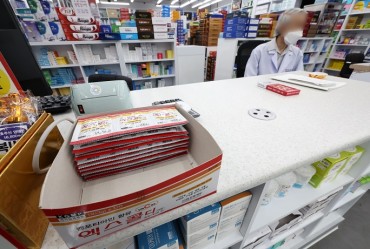
A team of the International Monetary Fund (IMF) said Tuesday that it has revised up its growth outlook for South Korea’s economy this year to 3.2 percent on a strong expansion in investment and improving export. (Image: Yonhap)
SEOUL, Nov. 14 (Korea Bizwire) — A team of the International Monetary Fund (IMF) said Tuesday that it has revised up its growth outlook for South Korea’s economy this year to 3.2 percent on a strong expansion in investment and improving export.
“The momentum is very strong. Especially in Q3, we felt that investment growth remained stronger than what we expected; exports still performed well,” Tarhan Feyzioglu, Korea Mission Chief of the IMF, said in a news conference in Seoul after wrapping up a two-week visit.
“And even when you adjust for all these changes in workdays and all that, still in the fourth quarter, we expect this momentum to continue, so 3.2 is quite feasible.”
The upward revision came a month after the IMF adjusted South Korea’s gross domestic product growth to 3 percent.
Last month, the BOK raised its growth outlook for the country’s GDP to 3 percent for 2017, up 0.2 percentage point from the central bank’s estimate released in July.
The BOK forecast country’s annual economic growth may reach 3.15 percent if the economy expands only 0.20 percent in the fourth quarter. An economic growth of 0.92 percent in the October-December period would translate to annual increase of 3.35 percent, according to the BOK.
The IMF team also said growth is forecast at around 3.0 percent in 2018, with private consumption growth benefiting from the large minimum wage increase and from policies supporting employment and social spending.
“The current growth momentum represents a good opportunity for ambitious structural reforms,” Feyzioglu said.
Separately, he said South Korea’s central bank should maintain its accommodative monetary stance, noting inflationary pressures are not strong and consumption growth could be stronger.
“Indeed, markets are already counting for about two increases. In our view, even after those two increases, the monetary stance will remain significantly accommodative,” Feyzioglu said.
The Bank of Korea is set to hold its rate review session on Nov. 30 to decide whether to keep or adjust the all-time low rate of 1.25 percent.
In October, the BOK kept its policy rate at that record-low level, extending its wait-and-see approach for the 16th consecutive month.
The central bank has said “conditions are gradually being created” for tightening its monetary easing stance, but it will monitor whether the trend of improved economic conditions is steady and can be sustained amid uncertainties such as geopolitical risks and trade-related developments with major countries.
Feyzioglu also said South Korea should increase the participation of women in the labor force to address its demographic problems, referring to a chronically low birthrate and rapidly aging population.
South Korea’s total fertility rate — the average number of children a woman bears in her lifetime — stood at 1.25 in 2016, much lower than the replacement level of 2.1 that would keep South Korea’s population of 51 million stable.
Last year, the number of South Koreans over 65 came to more than 6.76 million, accounting for 13.2 percent of all people living in the country, according to the country’s statistics office. Nations become an “aged society” if people aged over 65 make up 14 percent or more of the population.
(Yonhap)






